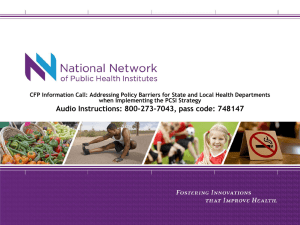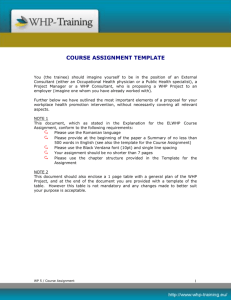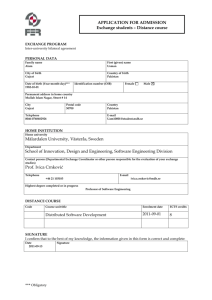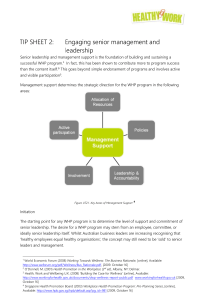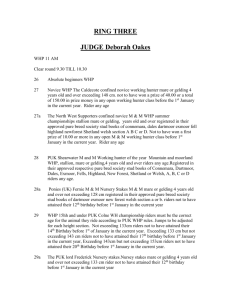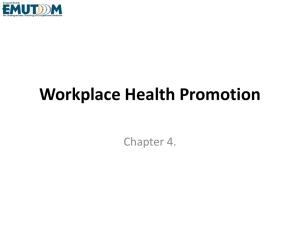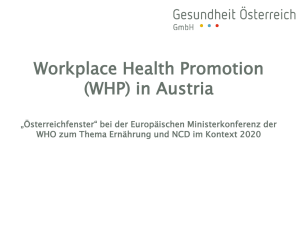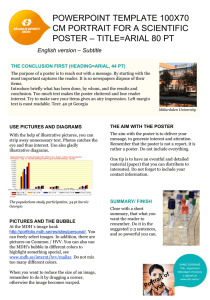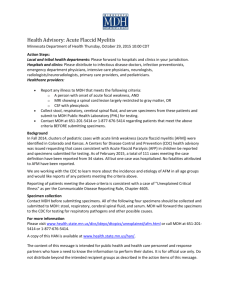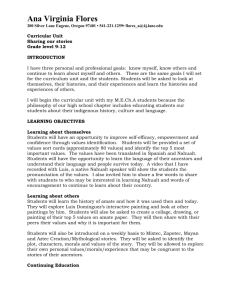PCSI - Minnesota Rural Water Association
advertisement
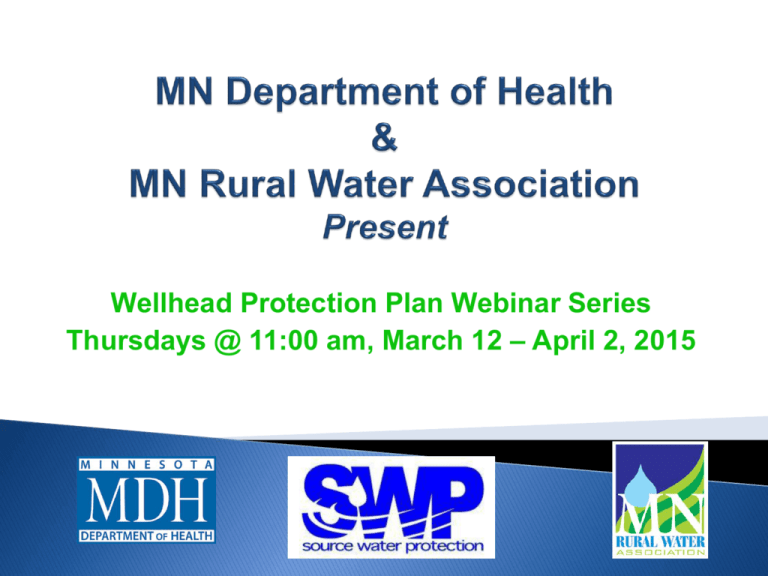
Wellhead Protection Plan Webinar Series Thursdays @ 11:00 am, March 12 – April 2, 2015 WEBINAR SERIES: March 12: General overview of WHP Planning Process March 19: In depth discussion and review of the Data Elements March 26: Requirements for completing a Potential Contaminant Source Inventory April 2: Developing well written Management Strategies ALL WEBINARS ARE BEING RECORDED AND WILL BE AVAILABLE AT: www.mrwa.com/sourcewater.html Refer to the “Best Practices for Attending the WHP Webinars using WebEx” sent to you Feb. 20th or available on MRWA website for screen sizing & directions for submittal of questions using WebEx Chat. Technical problems / questions can be submitted via WebEx chat and staff will respond to try and help resolve any technical problems as we get started. Webinar questions can be submitted during the session via WebEx Chat and will be answered at the end of each webinar. Materials for each webinar are available at: www.mrwa.com/sourcewater.html Why have a PCSI Webinar? Importance of the PCSI Requirements for a WHP Plan PCSI Process and Procedures for Completing a PCSI Technical Assistance Tools to Help 4 ANSWER THE QUESTION… “What do I need to do to successfully complete a PCSI for MDH approval? Clearer Expectations…! Picture Source: 2007 mongabay.com Other Really Good Reasons…. Most Common Reason for plan disapprovals by MDH Lost Time & Resources: PWS – Consultant - MDH MDH / Consultants share common goal to improve the process & service to mutual our client the PWS. Clarify WHP Rule Requirements / Expectations for completing a PCSI Explain MDH procedures for PCSI review & endorsement .” Cornerstone of a WHP Plan! WHP is proactive planning based on science and real threats… Eruption Cloud April 21, 1990. Mount Redoubt, Alaska. (Photo public domain courtesy of USGS.) PCSI is based on the vulnerability of the aquifer and public supply wells. Identify potential contaminant threats / land uses in the WHP area that may impact drinking water & public health! The PCSI helps the public water supplier “gauge risk” and “threats” and evaluate how to manage risk through the planning process. PCSI Insomnia… What threats keep you up at night? What lurks out there that might or could happen? Have you covered all the right bases? The PCSI Doctor says… PCSI Diligence: Ask questions about local PCS threats… Follow the Science / PCSI Scoping Notice & requirements! Double check work! Local Knowledge Matters! Local WHP Team Helps Complete PCSI PCSI Draft Complete: 1. Local review & approval 2. MDH PCSI endorsement Potential contaminant sources & land uses that present a threat to drinking water & public health are identified! WHP Management strategy options can be evaluated & developed that reduce risks to drinking water. Resources for WHP are directed in a cost effective manner…staff, time, money! .” WHP Rule Language Understanding the Relationship to Vulnerability Scoping 2 Decision Notice Potential Contaminant Source Lists Potential Contaminant Sources (PCS) & Attributes Required Materials Designations & Codes Required Status Designations & Codes WHP Planning Issues Summary A map and an inventory of the current and historical agricultural, residential, commercial, industrial, recreational, and institutional land uses and potential contaminant sources… Vulnerability guides the level and depth of a PCSI Not all PCSIs are created equal ! Commonly Inventoried… Low = other wells Moderate = other wells and chemical & petroleum storage tanks High = all land uses & potential contaminant sources Scoping 2 Decision Notice Attachments: ◦ Potential Contaminant Source Inventory List (based on vulnerability) PCS & codes Materials & codes Status & codes ◦ Summary of WHP Planning Issues Provides the “big picture view” of land use in the DWSMA Inner Wellhead Management Zone Specific to Vulnerability Attached to Scoping 2 Decision Notice Lists all the planning issues that have been identified to date List the data sets reviewed and assessed Describe methods used to verify and enhance raw data Discuss who helped conduct the PCSI Describe how local knowledge was used A land use/land cover map and table An inventory of the Inner Wellhead Management Zone(s) A list of all potential contaminant sources in the DWSMA Required attribute data for each PCS identified A map showing the locations of all PCS A narrative describing how the PCSI was conducted Early informal feedback on PCSI to PWS & Consultants Done at or before 60-day LUG review Complete PCSI package is submitted to planning & GIS staff WHP Rule data reporting requirements are met Electronic PCSI are submitted to MDH Facility designations and codes are no longer required Status designations and codes must be used Required attributes must be used A PCSI Narrative should be submitted PCSI Endorsement Procedures should be followed .” Setting the Stage: Where are you in the PCSI and WHP Planning Process? Has the Scoping II Meeting been held yet? Significance: If you have been hired to complete the Part II, WHP Plan, we recommend you attend to learn about the PCSI and other requirements / issues related to the Part II WHP Plan. Helpful Hint! This is also a good time to talk about number of WHP Team Meetings needed to do the Part II WHP Plan. Scoping II Notice – Sent to PWS after scoping meeting: 1) Identifies vulnerability & requirements for Part II, WHP Plan 2) Includes required “PCS Inventory list.” What to inventory… 3) Includes “Planning Issues Summary Form.” What issues were identified by MDH / MRWA staff that should be considered in Part II? Pre-PCSI Meeting Purpose: Meeting held with PWS, Consultant & MRWA or MDH Technical Assistance Planner (TAP) to coordinate & discuss completion of the PCSI. How Complex is the PCSI? Consider time needed to complete... PCSI Tools: Identify data sets, information needed to be reviewed and considered in completing the PCSI based on the vulnerability. PCSI TIPS 5) Involve WHP Team in review of PCSI! Historical Photo’s to locate former wells or other PCS Main Street Dodge Center, MN 1908 Photo Courtesy of MN History Center Courtesy of Geoff Nash, SWP Unit, MDH Courtesy of Geoff Nash, SWP Unit, MDH Hinckley DWMSA (WIMN) Tank Sites Map Note: Also See MPCA Tanks database for specific tank information Other Datasets & PCSI Resources: Local Information: PWS system hook-up information, storm water, septic system, feedlot information, etc. Pipelines Transportation Routes / Railways – possible spill locations MDA - Agriculture spills / release database Other - State / Federal / Local Databases & Information .” The consultant should verify that: the correct data, information was used to complete the PCSI (See Scoping II) New PCS attributes were used & status codes are complete Historical information and land uses were considered in the PCSI To the extent practical, local knowledge was used to verify and complete the PCSI. Apollo 11, July 20, 1969. Lunar Module Eagle Landing. Buzz Aldrin steps on Moon. Image Courtesy NASA PCSI Considerations for the WHP Team, Part II WHP Plan & Management Strategies: What are the important implications & issues of the PCSI to protecting the PWS wells, aquifer & public health? How can the PCSI best be applied to Lunar Orbit Photo: Moon Crater 308. Image Courtesy NASA reduce real risks and threats to drinking water? How can / will management strategies be prioritized and targeted? Last Steps! 1) WHP Team reviews & approves PCSI 2) Submit the PCSI to the MDH, MRWA Planner. 3) Submit PCSI electronic files to MDH GIS staff 4) PCSI reviewed & endorsed by MDH, MRWA staff (See MDH PCSI Endorsement Procedures Fact Sheet, April 2015) Orion’s first Flight test December 4, 2014. Goal: Mars and Deep Space Image Courtesy NASA .” Old Municipal Well Reports Assist PWS in updating IWMZ Provide IWMZ Reports to PWS & Consultant Provide Land use/Land cover Map and Table Provide Well Data; upon request MDH Planner MRWA Planner MDH GIS Staff April 2: Developing well written Management Strategies Reminder: All Webinars are being recorded and will be available at: www.mrwa.com/sourcewater.html Information in this document is available in alternative formats to individuals with disabilities upon request by calling or emailing George Minerich at (320) 223-7314 or email at George.Minerich@state.mn.us
